ASUS' N82Jv: Jack-Of-All-Trades
by Jarred Walton on September 11, 2010 11:10 PM ESTASUS N82Jv-X2 General Performance
We've been through this before, and our test suite remains the same as in recent laptop reviews, so let's jump right in and see how the N82Jv fares. Two key matchups are highlighted in the charts: the M11x R2 that has the same GPU but a slower ULV CPU, and the Toshiba A660D that represents something of the high water mark for current AMD notebooks.
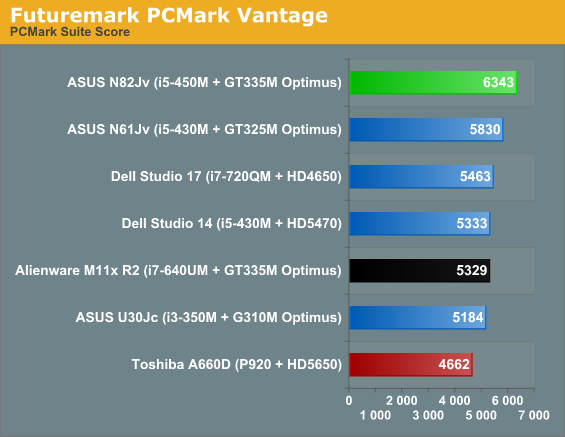
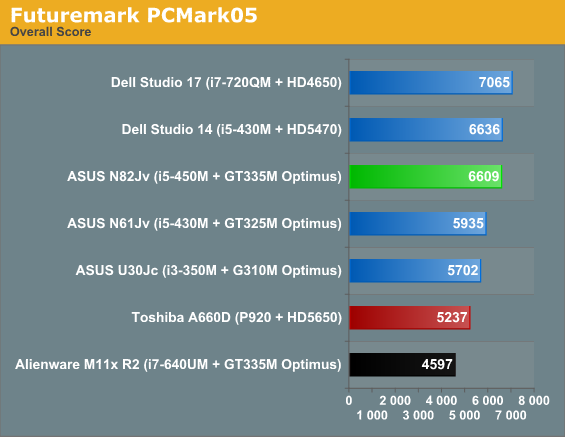
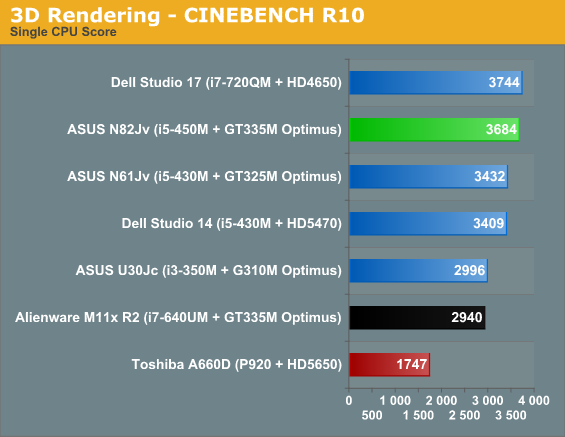

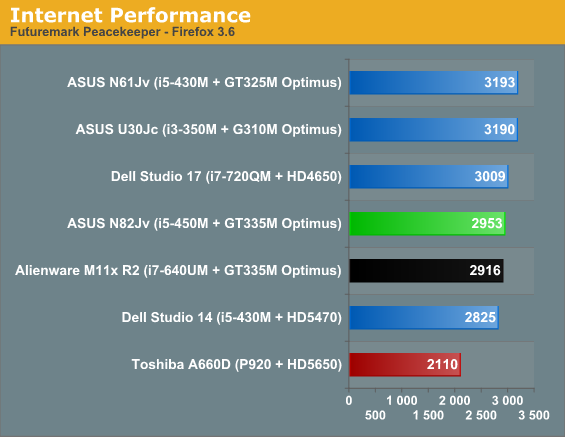
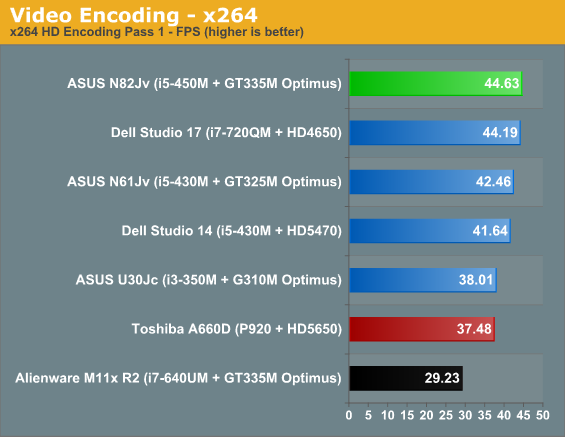
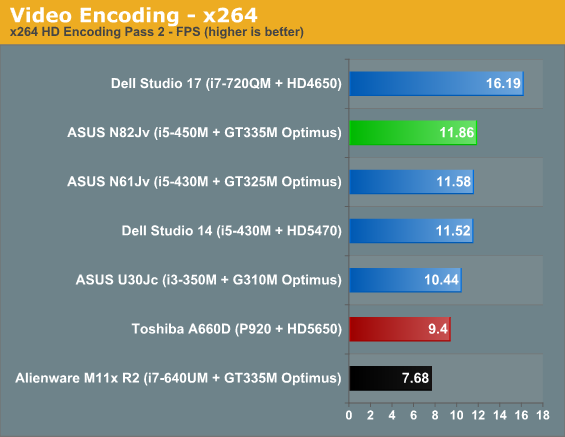
Right from the start, our two key comparisons show the N82Jv in a favorable light. Starting with the M11x R2, PCMark05 has the N82Jv leading the by 44%, while the Vantage result is "just" 19% higher. The close result of the M11x in Peacekeeper is an oddity…as is the loss to the slower clocked CPU/GPU of the N61Jv. It could be minor differences in the driver department, or perhaps the latest 3.6.8 Firefox updated reduced Peacekeeper performance. Regardless, we ran the test numerous times but the result was always lower than expected (and yet similar to the Studio 14). Peacekeeper is the exception to the rule, however. Cinebench gives the N82Jv a 25%/44% lead in the 1CPU/SMP tests, and the lead in x264 is just over 50% in both passes.
The comparison to the A660D leaves no question as to which processor is superior, with the lowest margin of victory coming at 20% in the first pass x264 encode—a test that's traditionally more HDD/bandwidth bound. PCMark has the N82Jv ahead by 36% in Vantage and 26% in 05, Peacekeeper gives the N82Jv a 40% lead, the single CPU Cinebench result is more than twice as fast as the P920, and the lead in multi-threaded tasks ranges from 20% to just over 30%. This is something we pointed out in the A660D review: when AMD's quad-core P920 can't come up with some clear wins over the i3-330M, it's a tough sell. Obviously, the i5-450M is faster than the 330M and simply increases Intel's lead; AMD's 2.0GHz N930 should come a lot closer to the Intel results in multi-threaded applications, but anything slower than that really needs to go after the value proposition.
Looking at the nearly identically equipped (outside of the GPU) Dell Studio 14, the N82Jv places about where we'd expect. The Vantage result favors ASUS by 19%, PCMark05 is a tie, but the remaining tests all give ASUS a lead of around 5% (give or take). It looks like ASUS has managed to better optimize the system performance, either with tighter memory timings, more BIOS tuning, or other tweaks. 5% is hardly anything to get worked up about, but it does show ASUS pays attention to some areas of performance more than many larger OEMs. $100 more for better performance, a significantly faster GPU, plus Optimus and USB 3.0 on top of that? Unless you can get the Studio 14 for a lot less than $900 for our tested system, the N82Jv is clearly a better choice.










33 Comments
View All Comments
FH123 - Sunday, September 12, 2010 - link
Good grief, how do you come up with those numbers? Show some consideration for people with different (yes, probably worse) eyes than yours. My preference is for 1024x768 at 14". My gripe is that the choice has gone away. My next choice would be 1280x800. Even that wasn't available in the low-weight, premium machine I bought. My ultimate choice would be something close to (laser) printed quality, e.g. 300 dpi upwards, and all the scaling problems solved by the OS. In the meantime, while we're at the resolutions you mention, I inevitably end up using some form of anti-aliasing, e.g. ClearType. That doesn't exactly make things better at the sort of awkward neither here (traditional screen < 100) nor there (traditional printer > 300) DPI we have at the moment.seanleeforever - Monday, September 13, 2010 - link
as a owner of both the BEST notebook screen in business, i think i know what i am talking about:screen resolution has absolutely NOTHING to do with screen quality, period. you guys are simply drinking Kool-Aid that notebook company tend to sell you. a higher resolution screen doesn't make it better than lower resolution screen, just as a 17 inch notebook is not better than 12 inch notebook (except it is larger).
the technology used in the panel is what decides screen quality. i have HP dream color 2 on my elitebook and outdoor screen on my x201 tablet. both uses 10 bit IPS screen that delivers superb image with NO color distortion at any angel, both are 300~400 dollar option on the top of the SAME RESOLUTION screen.
a good screen cost A lot of money, much higher than simply put more pixel on the screen. that's why notebook manufacturers try to fool you.
simply put, i will love to a 1200*800 ips than blue LED TN screen of any resolution.
Roland00 - Sunday, September 12, 2010 - link
You don't need direct x 11 with a laptop. Any game that you would want direct x 11 you would want a card that is faster than a 9800gt (aka 5750 or GTS 450 desktop parts) or else the card would be too slow to perform an acceptable frame rate with direct x 11 effects added on. Now in theory a game could be "completely" direct x 11 where you wouldn't have a direct x 9 or direct x 10 mode but this won't happen for games are developed for consoles and are developed for pc marketshare and too few people have direct x 11 cards thus their will be a direct x 9 and/or direct x 10 code path.That said the upcoming 400 series nvidia cards are looking to be faster than this card for they have a higher amount of shaders (the 420m, 430m, and 435m will all have 96 shaders, the difference between each model is the core clock and the shader clock, they have identical memory bandwidth). Whether this will provide an insignificant boost slightly different architecture, and/or memory bandwidth is anybody guess but I wouldn't be surprised to see at least a 20% performance boost for they have 25% more shader hardware, and all even the 420m has higher clocks than the 335m. (and the 435m is 30% faster on the core and shader clock compared to the 420m).
Get the 400 series not because of direct x11 but because it will be a faster card, and battery life isn't a big deal due to optimus.
Voldenuit - Sunday, September 12, 2010 - link
What use is a low-end DX11 GPU? Even midrange desktop DX11 GPUs struggle with DX11 games, so they are doubly useless on a laptop.A DX10 GPU can do most anything a DX11 one can.
DirectCompute? Check.
CUDA? Check.
OpenCL? Check.
PhysX? Check (not that you'd want to turn on Physx on a laptop, unless you were a masochist).
If you're building a high end (or even midrange) desktop, DX11 is the clear choice, but on the mobile front, it's hardly essential.
I do agree that with the shoddy battery, lousy screen and mediocre keyboard, there isn't much to entice me with the ASUS in any case.
Aaluran - Sunday, September 12, 2010 - link
I couldn't possibly agree more with this article. The LCD is an annoyance, but one I can live with, but that battery is laughable compared to the 84Wh one. This laptop is perfect as a second computer, but 47Wh is simply unaccpetable.strikeback03 - Monday, September 13, 2010 - link
That is one point I disagree on, IMO 3-4 hrs is good enough for a lot of mainstream users. Make a larger one available (as part of the purchase) for those who want it, but I find the LCD far more a problem than the battery.blackrook - Sunday, September 12, 2010 - link
The last two pages of this article just scream "HP Envy 14 with radiance screen!" to me. It's a huge shame Anandtech doesn't appear to have one on hand. I was surprised it was never mentioned. This is a laptop with:-magnesium/aluminum chassis
-switchable 5650 graphics (albeit underclocked and not Optimus)
-sensational screen
-acceptable battery capacity (59Wh?)
And it seems to be making waves. The Envy 14 upon initial release originally came standard with the radiance screen at $1099, until demand seemed to outpace supply. It became $999 with a standard brightview screen, radiance being as a $200 option. Since then the radiance screen has ballooned to a $300 premium. That's how much perceived value a quality screen is worth to consumers, and it stuns me why more manufacturers haven't tried to go the same route HP has with the Envy 14.
Just some food for thought.
The Crying Man - Sunday, September 12, 2010 - link
Jarred mentioned that an Envy 14 was on it's way some weeks ago. Hopefully it's in the process of being reviewed now.JarredWalton - Sunday, September 12, 2010 - link
It still hasn't arrived... it seems HP can be like that. Plus, the current Envy 14 is now what, 6 months old? It's about due for an update.blackrook - Sunday, September 12, 2010 - link
It released in late June, and first day buyers started receiving them early July. So that'd make it around two and a half months old.So HP was supposed to send over a review unit and it never arrived? :S
*shakes head*